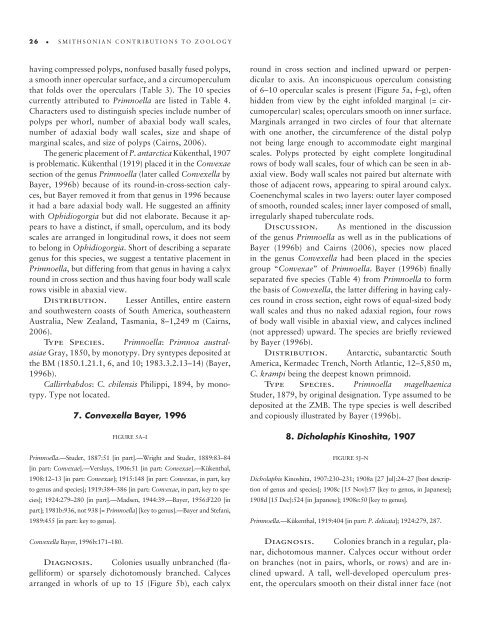A Generic Revision and Phylogenetic Analysis of the Primnoidae
A Generic Revision and Phylogenetic Analysis of the Primnoidae
A Generic Revision and Phylogenetic Analysis of the Primnoidae
Create successful ePaper yourself
Turn your PDF publications into a flip-book with our unique Google optimized e-Paper software.
26 SMITHSONIAN CONTRIBUTIONS TO ZOOLOGY<br />
having compressed polyps, nonfused basally fused polyps,<br />
a smooth inner opercular surface, <strong>and</strong> a circumoperculum<br />
that folds over <strong>the</strong> operculars (Table 3). The 10 species<br />
currently attributed to Primnoella are listed in Table 4.<br />
Characters used to distinguish species include number <strong>of</strong><br />
polyps per whorl, number <strong>of</strong> abaxial body wall scales,<br />
number <strong>of</strong> adaxial body wall scales, size <strong>and</strong> shape <strong>of</strong><br />
marginal scales, <strong>and</strong> size <strong>of</strong> polyps (Cairns, 2006).<br />
The generic placement <strong>of</strong> P. antarctica Kükenthal, 1907<br />
is problematic. Kükenthal (1919) placed it in <strong>the</strong> Convexae<br />
section <strong>of</strong> <strong>the</strong> genus Primnoella (later called Convexella by<br />
Bayer, 1996b) because <strong>of</strong> its round-in-cross-section calyces,<br />
but Bayer removed it from that genus in 1996 because<br />
it had a bare adaxial body wall. He suggested an affi nity<br />
with Ophidiogorgia but did not elaborate. Because it appears<br />
to have a distinct, if small, operculum, <strong>and</strong> its body<br />
scales are arranged in longitudinal rows, it does not seem<br />
to belong in Ophidiogorgia. Short <strong>of</strong> describing a separate<br />
genus for this species, we suggest a tentative placement in<br />
Primnoella, but differing from that genus in having a calyx<br />
round in cross section <strong>and</strong> thus having four body wall scale<br />
rows visible in abaxial view.<br />
Distribution. Lesser Antilles, entire eastern<br />
<strong>and</strong> southwestern coasts <strong>of</strong> South America, sou<strong>the</strong>astern<br />
Australia, New Zeal<strong>and</strong>, Tasmania, 8–1,249 m (Cairns,<br />
2006).<br />
Type Species. Primnoella: Primnoa australasiae<br />
Gray, 1850, by monotypy. Dry syntypes deposited at<br />
<strong>the</strong> BM (1850.1.21.1, 6, <strong>and</strong> 10; 1983.3.2.13–14) (Bayer,<br />
1996b).<br />
Callirrhabdos: C. chilensis Philippi, 1894, by monotypy.<br />
Type not located.<br />
7. Convexella Bayer, 1996<br />
FIGURE 5A–I<br />
Primnoella.—Studer, 1887:51 [in part].—Wright <strong>and</strong> Studer, 1889:83–84<br />
[in part: Convexae].—Versluys, 1906:51 [in part: Convexae].—Kükenthal,<br />
1908:12–13 [in part: Convexae]; 1915:148 [in part: Convexae, in part, key<br />
to genus <strong>and</strong> species]; 1919:384–386 [in part: Convexae, in part, key to species];<br />
1924:279–280 [in part].—Madsen, 1944:39.—Bayer, 1956:F220 [in<br />
part]; 1981b:936, not 938 [= Primnoella] [key to genus].—Bayer <strong>and</strong> Stefani,<br />
1989:455 [in part: key to genus].<br />
Convexella Bayer, 1996b:171–180.<br />
Diagnosis. Colonies usually unbranched (fl agelliform)<br />
or sparsely dichotomously branched. Calyces<br />
arranged in whorls <strong>of</strong> up to 15 (Figure 5b), each calyx<br />
round in cross section <strong>and</strong> inclined upward or perpendicular<br />
to axis. An inconspicuous operculum consisting<br />
<strong>of</strong> 6–10 opercular scales is present (Figure 5a, f–g), <strong>of</strong>ten<br />
hidden from view by <strong>the</strong> eight infolded marginal (= circumopercular)<br />
scales; operculars smooth on inner surface.<br />
Marginals arranged in two circles <strong>of</strong> four that alternate<br />
with one ano<strong>the</strong>r, <strong>the</strong> circumference <strong>of</strong> <strong>the</strong> distal polyp<br />
not being large enough to accommodate eight marginal<br />
scales. Polyps protected by eight complete longitudinal<br />
rows <strong>of</strong> body wall scales, four <strong>of</strong> which can be seen in abaxial<br />
view. Body wall scales not paired but alternate with<br />
those <strong>of</strong> adjacent rows, appearing to spiral around calyx.<br />
Coenenchymal scales in two layers: outer layer composed<br />
<strong>of</strong> smooth, rounded scales; inner layer composed <strong>of</strong> small,<br />
irregularly shaped tuberculate rods.<br />
Discussion. As mentioned in <strong>the</strong> discussion<br />
<strong>of</strong> <strong>the</strong> genus Primnoella as well as in <strong>the</strong> publications <strong>of</strong><br />
Bayer (1996b) <strong>and</strong> Cairns (2006), species now placed<br />
in <strong>the</strong> genus Convexella had been placed in <strong>the</strong> species<br />
group “Convexae” <strong>of</strong> Primnoella. Bayer (1996b) fi nally<br />
separated fi ve species (Table 4) from Primnoella to form<br />
<strong>the</strong> basis <strong>of</strong> Convexella, <strong>the</strong> latter differing in having calyces<br />
round in cross section, eight rows <strong>of</strong> equal-sized body<br />
wall scales <strong>and</strong> thus no naked adaxial region, four rows<br />
<strong>of</strong> body wall visible in abaxial view, <strong>and</strong> calyces inclined<br />
(not appressed) upward. The species are briefl y reviewed<br />
by Bayer (1996b).<br />
Distribution. Antarctic, subantarctic South<br />
America, Kermadec Trench, North Atlantic, 12–5,850 m,<br />
C. krampi being <strong>the</strong> deepest known primnoid.<br />
Type Species. Primnoella magelhaenica<br />
Studer, 1879, by original designation. Type assumed to be<br />
deposited at <strong>the</strong> ZMB. The type species is well described<br />
<strong>and</strong> copiously illustrated by Bayer (1996b).<br />
8. Dicholaphis Kinoshita, 1907<br />
FIGURE 5J–N<br />
Dicholaphis Kinoshita, 1907:230–231; 1908a [27 Jul]:24–27 [best description<br />
<strong>of</strong> genus <strong>and</strong> species]; 1908c [15 Nov]:57 [key to genus, in Japanese];<br />
1908d [15 Dec]:524 [in Japanese]; 1908e:50 [key to genus].<br />
Primnoella.—Kükenthal, 1919:404 [in part: P. delicata]; 1924:279, 287.<br />
Diagnosis. Colonies branch in a regular, planar,<br />
dichotomous manner. Calyces occur without order<br />
on branches (not in pairs, whorls, or rows) <strong>and</strong> are inclined<br />
upward. A tall, well-developed operculum present,<br />
<strong>the</strong> operculars smooth on <strong>the</strong>ir distal inner face (not

















